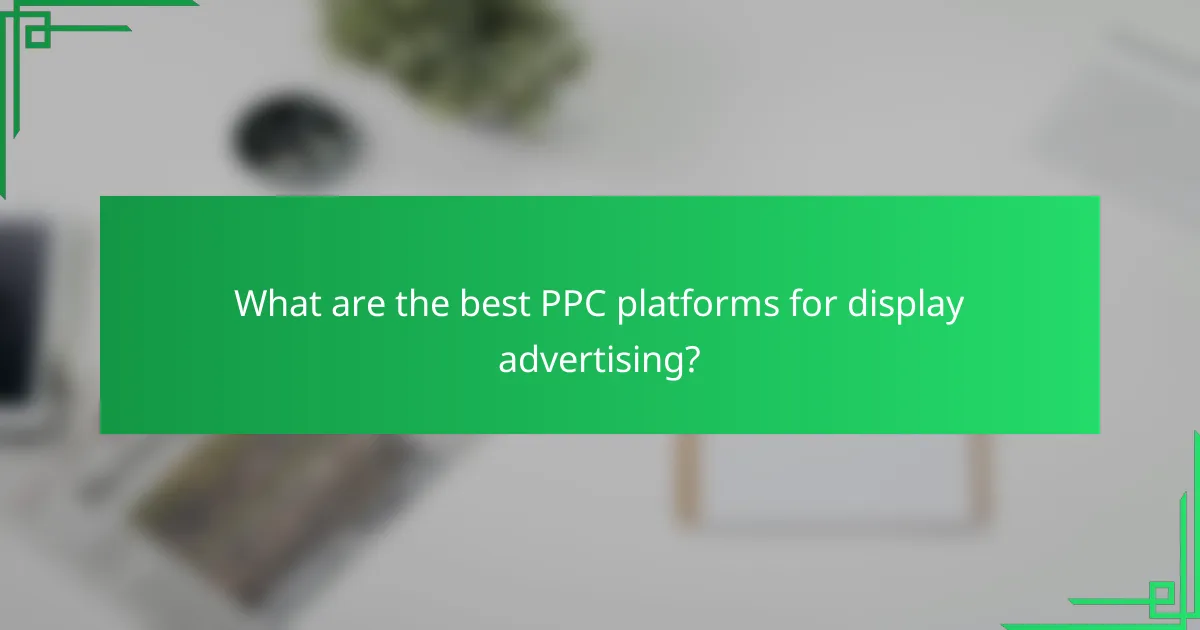PPC advertising is a powerful strategy for driving immediate traffic and enhancing visibility on search engines and popular platforms. It not only allows businesses to reach targeted audiences quickly but also provides measurable results, enabling them to assess campaign effectiveness through key performance indicators. With careful budget control and strategic planning, advertisers can optimize their spending to achieve maximum impact and return on investment.

How does PPC advertising drive immediate traffic in the UK?
PPC advertising effectively drives immediate traffic in the UK by placing ads prominently on search engines and popular platforms, ensuring quick visibility to potential customers. This method allows businesses to reach targeted audiences instantly, making it a powerful tool for generating leads and sales.
Instant visibility on search engines
PPC ads appear at the top of search engine results pages, giving them prime visibility. When users search for relevant keywords, these ads can be displayed within seconds, attracting clicks from interested parties. This immediacy contrasts with organic search strategies, which may take weeks or months to gain traction.
For example, a local bakery running a PPC campaign for “best cupcakes in London” can see their ad at the top of search results almost immediately after launching the campaign, driving traffic right away.
Targeted audience reach
PPC advertising allows businesses to target specific demographics, locations, and interests, ensuring that ads reach the most relevant audience. Advertisers can set parameters based on age, gender, location, and even user behavior, maximizing the chances of conversion.
In the UK, a company selling eco-friendly products can target environmentally conscious consumers within specific cities, ensuring that their ads are seen by those most likely to be interested in their offerings.
Ad placements on popular platforms
PPC ads can be placed on various platforms, including Google, Bing, and social media sites like Facebook and Instagram. This diversity allows businesses to choose where their ads will be most effective based on their target audience’s online behavior.
For instance, a fashion retailer might find that Instagram ads yield higher engagement rates among younger demographics, while Google Ads may be more effective for capturing intent-driven searches from older consumers looking for specific products.

What measurable results can be achieved with PPC advertising?
PPC advertising can yield several measurable results, including increased website traffic, improved conversion rates, and a clear return on investment. By analyzing key performance indicators, businesses can assess the effectiveness of their campaigns and make data-driven decisions.
Click-through rates (CTR)
Click-through rate (CTR) measures the percentage of users who click on an ad after seeing it. A higher CTR indicates that the ad is engaging and relevant to the audience. Typical CTRs for search ads can range from 2% to 5%, while display ads often see lower rates, typically around 0.5% to 1%.
To improve CTR, focus on crafting compelling ad copy and utilizing targeted keywords. A/B testing different headlines and descriptions can also help identify what resonates best with your audience.
Conversion tracking
Conversion tracking allows advertisers to measure specific actions taken by users after clicking on an ad, such as making a purchase or signing up for a newsletter. This data is crucial for understanding the effectiveness of PPC campaigns and optimizing them for better performance.
Setting up conversion tracking typically involves adding a small piece of code to your website. Platforms like Google Ads provide straightforward instructions for implementation. Regularly reviewing conversion data can help identify which ads and keywords are driving the most valuable actions.
Return on ad spend (ROAS)
Return on ad spend (ROAS) is a metric that measures the revenue generated for every dollar spent on advertising. A common benchmark for a healthy ROAS is around 4:1, meaning for every $1 spent, $4 in revenue is generated. However, this can vary based on industry and campaign goals.
To maximize ROAS, continually analyze your ad performance and adjust bids, targeting, and ad creatives accordingly. Avoid overspending on low-performing keywords and focus on those that deliver the best returns.

How can budget control be maintained in PPC campaigns?
Budget control in PPC campaigns can be effectively maintained through strategic planning and monitoring. By setting clear financial limits and adjusting bids based on performance, advertisers can optimize their spending while achieving desired results.
Daily budget limits
Setting daily budget limits is crucial for managing overall spending in PPC campaigns. This ensures that you do not exceed your allocated budget for the day, allowing for consistent performance without unexpected costs. For example, if your daily budget is set at $50, once your ads reach this amount, they will stop showing until the next day.
When establishing daily limits, consider your overall marketing budget and the expected return on investment (ROI). It’s advisable to start with a conservative budget and adjust based on performance data over time.
Bid adjustments based on performance
Bid adjustments based on performance allow advertisers to optimize their ad spend by increasing or decreasing bids according to how well specific keywords or ads are performing. For instance, if a keyword is generating a high conversion rate, increasing its bid can enhance visibility and drive more traffic.
Regularly reviewing performance metrics, such as click-through rates (CTR) and conversion rates, can inform these adjustments. Aim for a balance where you maximize visibility for high-performing ads while minimizing spend on underperforming ones.
Utilizing automated bidding strategies
Automated bidding strategies can simplify budget control by using algorithms to adjust bids in real-time based on performance data and competition. These strategies can help you achieve specific goals, such as maximizing conversions or maintaining a target cost per acquisition (CPA).
Common automated bidding options include Target CPA, Target ROAS, and Maximize Clicks. Each strategy has its own strengths, so choose one that aligns with your campaign objectives. Regularly monitor performance to ensure the automated strategy is meeting your expectations and adjust settings as necessary.

What are the best PPC platforms for display advertising?
The best PPC platforms for display advertising include Google Ads, Facebook Ads, and LinkedIn Ads. Each platform offers unique features and targeting options that can help businesses reach their specific audiences effectively.
Google Ads
Google Ads is one of the most popular platforms for display advertising, allowing advertisers to create visually appealing ads that appear on websites within the Google Display Network. This network includes millions of sites, giving businesses extensive reach.
When using Google Ads, consider utilizing targeting options such as demographics, interests, and remarketing to effectively reach potential customers. A common strategy is to allocate a budget based on your overall marketing goals, often starting with a few hundred to a few thousand dollars per month.
Facebook Ads
Facebook Ads provides a robust platform for display advertising, leveraging its vast user data to target specific demographics and interests. Advertisers can create visually engaging ads that appear in users’ news feeds and on the right-hand side of the platform.
To maximize effectiveness, use Facebook’s audience insights to refine your targeting. Setting a daily budget can help control spending, with many businesses starting with a budget of around $5 to $50 per day to test ad performance.
LinkedIn Ads
LinkedIn Ads is ideal for B2B advertising, allowing businesses to target professionals based on industry, job title, and company size. This platform is particularly effective for promoting services and products to a business audience.
When advertising on LinkedIn, consider using sponsored content or text ads to engage your target audience. A budget of several hundred dollars per month is common, especially for niche markets, ensuring you reach the right professionals effectively.

What are the prerequisites for launching a PPC campaign?
To successfully launch a PPC campaign, you need to establish a clear understanding of your target audience, set specific campaign goals, and conduct thorough keyword research. These prerequisites ensure that your advertising efforts are focused and effective, maximizing your return on investment.
Defining target audience
Identifying your target audience is crucial for a successful PPC campaign. This involves understanding demographics such as age, gender, location, and interests, which helps tailor your ads to the right people. For instance, if you are selling high-end electronics, your audience may be tech-savvy individuals aged 25-45 in urban areas.
Utilizing tools like Google Analytics and social media insights can provide valuable data about your audience’s behavior and preferences. This information allows you to create more relevant ads that resonate with potential customers, increasing the likelihood of clicks and conversions.
Setting clear campaign goals
Establishing clear goals for your PPC campaign is essential for measuring success. Common objectives include increasing website traffic, generating leads, or boosting sales. Defining these goals helps you determine the right metrics to track, such as click-through rates (CTR) or conversion rates.
Consider using the SMART criteria—Specific, Measurable, Achievable, Relevant, and Time-bound—to outline your goals. For example, instead of saying “increase sales,” specify “increase online sales by 20% over the next three months.” This clarity will guide your campaign strategy and adjustments.
Keyword research and selection
Effective keyword research is a foundational step in any PPC campaign. It involves identifying the terms and phrases your target audience uses when searching for products or services like yours. Tools such as Google Keyword Planner can help you find relevant keywords with good search volume and manageable competition.
When selecting keywords, focus on a mix of broad and long-tail keywords. Broad keywords reach a wider audience but may have higher competition, while long-tail keywords are more specific and often lead to higher conversion rates. For example, instead of just targeting “shoes,” consider “women’s running shoes size 8.” This specificity can lead to more qualified traffic.

How to optimize PPC campaigns for better performance?
To optimize PPC campaigns for better performance, focus on refining your strategies through testing, targeting, and analysis. Implementing A/B testing, refining keyword targeting, and analyzing competitor strategies are key steps to enhance your campaign’s effectiveness and return on investment.
A/B testing ad creatives
A/B testing ad creatives involves comparing two or more variations of an ad to determine which performs better. This method helps identify the most effective headlines, images, and calls to action, allowing you to allocate your budget more efficiently.
Start by creating two versions of your ad with one differing element, such as the headline or image. Monitor performance metrics like click-through rates (CTR) and conversion rates over a set period. Aim for a sample size that provides statistically significant results, typically in the low hundreds to thousands, depending on your traffic volume.
Refining keyword targeting
Refining keyword targeting is crucial for reaching the right audience and maximizing your PPC budget. Focus on long-tail keywords that are specific to your products or services, as they often have lower competition and higher conversion rates.
Utilize tools like Google Ads Keyword Planner to identify relevant keywords and assess their search volume and competition. Regularly review and update your keyword list, removing underperforming keywords and adding new ones based on trends and user behavior.
Analyzing competitor strategies
Analyzing competitor strategies can provide valuable insights into what works in your industry. By examining their ad copies, keywords, and landing pages, you can identify gaps in your own strategy and discover new opportunities.
Use tools like SEMrush or SpyFu to gain visibility into your competitors’ PPC campaigns. Look for trends in their ad spend, keyword choices, and promotional tactics. This analysis can inform your bidding strategies and help you differentiate your offerings in a crowded market.
